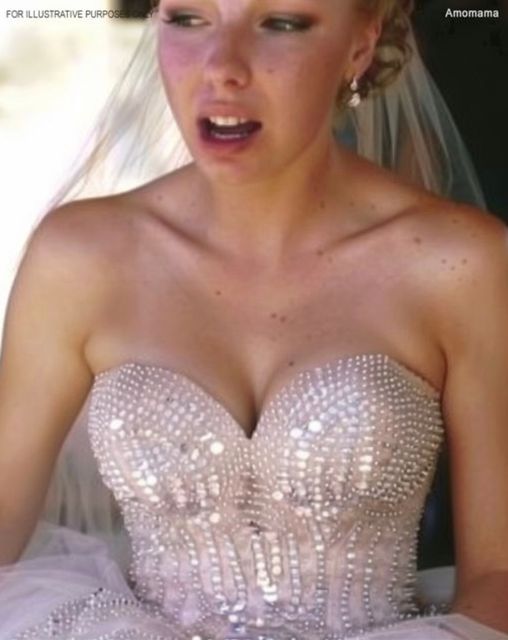
As my wedding day approached, I uncovered my half-sister Heather’s intention to outshine me by wearing a radiant white crystal dress. Confronted with this unexpected challenge, I meticulously crafted a strategy that would either safeguard the sanctity of my special day or potentially spark an intense family rivalry.
Hi everyone, I’m Iris, and I’m eager to share a tale of wedding intrigue, where familial conflicts and bridal fashion dramatically intersect. So, settle in as we delve into a day marked by calculated maneuvers and sparkling gowns.
Understanding the saga requires a peek into our family’s complex history. Picture this: Heather and I are both 24, sharing not just a birth month but a father whose decisions have cast long shadows over our lives. His departure from my pregnant mother to start a new life with Heather’s mother set a frosty tone for all subsequent family interactions.
From our earliest years, Heather and I were pitted against each other in a silent contest we never volunteered for. Our parents’ split loyalties created an undercurrent of tension that quietly dictated the dynamics of our relationship.
Despite these challenges, Heather and her mother openly displayed their disdain for my mother and me. Their coldness thwarted any hopes of sisterly affection, casting a chill on our interactions that was hard to ignore.
Fast forward to recent events, my fiancé Chace and I were basking in the joy of our engagement, with our wedding planned for the following Saturday. In contrast to Heather’s penchant for opulence, I chose a modest white dress symbolizing the purity and sincerity of our love—eschewing elaborate decorations for simple elegance.
However, the serene landscape of our wedding preparations was disrupted when I received a startling message from my cousin Charlotte. She forwarded a text from Heather, complete with a photo of the extravagant dress intended for my wedding. The caption smugly declared, “This jerk must know, she isn’t the most beautiful.” The audacity of her message was both shocking and infuriating.
The gown was a spectacle: a strapless masterpiece encrusted with crystals and golden embellishments, designed to dazzle and dominate. It was a clear challenge, a brazen attempt to eclipse the bride on her own wedding day.
Fury surged within me, but it was quickly replaced by a strategic calm. Why should I allow Heather’s theatrics to mar my day? Instead, I saw an opportunity to subvert her flashy display into a powerful lesson in humility.
As the wedding day dawned, anticipation hung in the air. Guests arrived in waves, murmuring greetings and admiring the decor. Then came Heather, resplendent in her gleaming white gown, her entrance calculated to attract awe and attention. However, her confident stride faltered as she encountered an unexpected sight.
There, across the venue, were my bridesmaids, each adorned in a gown mirroring Heather’s. The identical dresses—equally resplendent with white fabric, crystals, and gold—rendered her ‘unique’ choice less a statement than a standard. The bridesmaids’ smirks were barely concealed as they took in Heather’s stunned reaction, her planned moment of triumph dissolving into a spectacle of redundancy.
The ripple of realization spread through the assembled guests, sparking whispers and discreet laughter. Heather’s attempt to stand out had spectacularly backfired, transforming her into just another part of the bridal tableau.
Amidst the subdued chatter and chuckles, I approached Heather with a proposal, cloaked in grace yet underscored by irony. “Heather, how about you join the bridesmaids?” I suggested. The complexity of emotions that crossed her face—surprise, confusion, and a grudging acknowledgment—was a sight to behold.
Later, as the reception unfolded, I took a moment during the speeches to publicly acknowledge my bridesmaids. Holding the microphone, I expressed, “I want to give a special shoutout to my wonderful bridesmaids for their extra special effort today. It’s moments like these that underscore the importance of family and friends who support and uplift each other.” The applause that followed was warm, the message resonant, particularly with Heather.
The remainder of the evening saw a marked change in Heather’s demeanor. The bold, brash sister who had aimed to overshadow the bride was now a quieter, more contemplative participant in the festivities. It seemed that the day’s events had offered her a new perspective on family, rivalry, and the true meaning of a wedding celebration.
As the night drew to a close, the transformation in Heather was evident to all. What began as a day poised for conflict ended in a celebration of unity and love, a testament to the power of strategic kindness over petty competition.
Reflecting on the events, I pondered the delicate balance between defending one’s joy and fostering reconciliation. By choosing to outplay Heather in such a public yet dignified manner, I hoped not only to protect my wedding day but also to offer a lesson in grace and magnanimity.
As I share this story, I invite you to weigh in. Was my approach to managing Heather’s challenge justified, or might there have been a more straightforward path to harmony? How would you navigate such a familial minefield?
This experience, while fraught with potential for discord, ultimately reinforced the bonds of family and friendship, reminding us all of the enduring power of love and unity—even in the face of deep-seated rivalry.
Leave a Reply